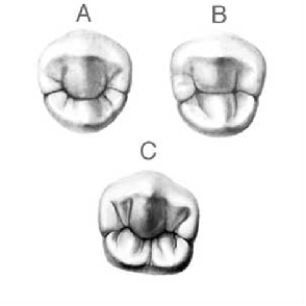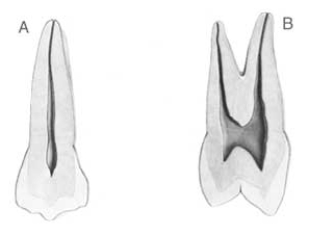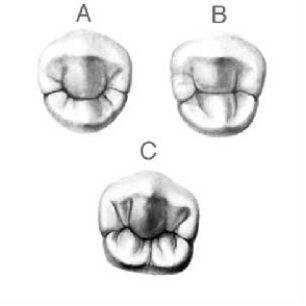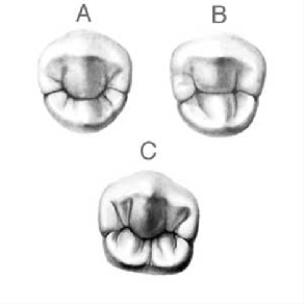A) Two roots,one mesial and one distal
B) Two roots,one buccal and one lingual
C) Fused roots
D) One root only
F) A) and B)
Correct Answer

verified
B
Correct Answer
verified
Multiple Choice
In figure "B" below,identify the tooth,the number of cusps,and groove pattern.

A) Mandibular second premolar;two cusps;"H" groove pattern
B) Mandibular second premolar;two cusps;"Y" groove pattern
C) Mandibular first premolar;two cusps;"U" groove pattern
D) Mandibular second premolar;three cusps;"U" groove pattern
F) B) and C)
Correct Answer

verified
Correct Answer
verified
Multiple Choice
Which of the following are true of the maxillary second premolars (Select all that apply. ) ?
A) Evidence of calcification is seen at 2 years of age.
B) Completion of enamel formation occurs at 4 years of age.
C) Eruption occurs at 11 to 13 years of age.
D) Root formation is completed by 12 to 14 years of age.
F) A) and D)
Correct Answer

verified
Correct Answer
verified
Multiple Choice
Figure "B" below illustrates a view of which surface?

A) Buccal
B) Lingual
C) Mesial
D) Distal
F) None of the above
Correct Answer

verified
Correct Answer
verified
Multiple Choice
The overall height of the premolars is longer than that of the canines because the root of the premolars is considerably longer than those of the canines.
A) Both the statement and the reason are correct and related.
B) Both the statement and the reason are correct but are NOT related.
C) The statement is correct,but the reason is NOT correct.
D) The statement is NOT correct,but the reason is correct.
E) NEITHER the statement NOR the reason is correct.
G) A) and C)
Correct Answer

verified
Correct Answer
verified
Multiple Choice
Premolars erupt between 9 and 12 years of age.Premolars are the succedaneous teeth that replace primary canines.
A) Both statements are true.
B) The first statement is true;the second statement is false.
C) The first statement is false;the second statement is true.
D) Both statements are false.
F) A) and C)
Correct Answer

verified
D
Correct Answer
verified
Multiple Choice
Which premolar has the smallest lingual cusp?
A) Maxillary first
B) Maxillary second
C) Mandibular first
D) Mandibular second
F) A) and D)
Correct Answer

verified
Correct Answer
verified
Multiple Choice
In figure "C" below,identify the tooth,the number of cusps,and groove pattern.

A) Mandibular second premolar;three cusps;"Y" groove pattern
B) Mandibular first premolar;three cusps;"H" groove pattern
C) Mandibular first premolar;three cusps;"U" groove pattern
D) Mandibular second premolar;two cusps;"C" groove pattern
F) B) and C)
Correct Answer

verified
Correct Answer
verified
Multiple Choice
Mandibular first premolars typically have two roots,a mesial and a distal.An anomaly is formation of a third auxiliary root.
A) Both statements are true.
B) The first statement is true;the second statement is false.
C) The first statement is false;the second statement is true.
D) Both statements are false.
F) B) and D)
Correct Answer

verified
Correct Answer
verified
Multiple Choice
Figure "A" below is which tooth?

A) Maxillary right second premolar
B) Maxillary left second premolar
C) Maxillary right first premolar
D) Maxillary left first premolar
F) A) and B)
Correct Answer

verified
Correct Answer
verified
Multiple Choice
Which of the following are located on the occlusal surfaces of premolars (Select all that apply. ) ?
A) Marginal ridges
B) Transverse ridges
C) Triangular ridges
D) Premolar eminence
F) All of the above
Correct Answer

verified
Correct Answer
verified
Multiple Choice
Which premolar has buccal and lingual cusps that are almost the same height?
A) Maxillary first
B) Maxillary second
C) Mandibular first
D) Mandibular second
E) None of the above
G) A) and B)
Correct Answer

verified
Correct Answer
verified
Multiple Choice
In figure "A" below,identify the tooth,the number of cusps,and groove pattern.

A) Mandibular first premolar;two cusps;"C" groove pattern
B) Mandibular second premolar;two cusps;"Y" groove pattern
C) Mandibular first premolar;two cusps;"H" groove pattern
D) Mandibular second premolar;two cusps;"U" groove pattern
F) B) and D)
Correct Answer

verified
Correct Answer
verified
Multiple Choice
The mandibular second premolar shows evidence of calcification at 2.5 years.Completion of enamel formation does not occur,until 11 to 12 years.
A) Both statements are true.
B) The first statement is true;the second statement is false.
C) The first statement is false;the second statement is true.
D) Both statements are false.
F) A) and B)
Correct Answer

verified
B
Correct Answer
verified
Multiple Choice
Which of the following are true of both maxillary first premolars and maxillary second premolars (Select all that apply. ) ?
A) Both have two cusps.
B) Both have two roots.
C) Both are formed from four developmental lobes.
D) Both have two pulp horns.
F) A) and D)
Correct Answer

verified
Correct Answer
verified
Multiple Choice
Each of the following is evident on a maxillary first premolar EXCEPT one.Which one is the EXCEPTION?
A) Mesial marginal groove
B) Mesial developmental depression
C) Mesial marginal ridge
D) Distinct distal marginal ridge
E) Two small,afunctional lingual cusp tips
G) C) and D)
Correct Answer

verified
Correct Answer
verified
Multiple Choice
As a rule,the mandibular first premolars are always smaller than the mandibular second premolars.The most striking identifying feature of the mandibular first premolar is the mesiolingual developmental groove.
A) Both statements are true.
B) The first statement is true;the second statement is false.
C) The first statement is false;the second statement is true.
D) Both statements are false.
F) C) and D)
Correct Answer

verified
Correct Answer
verified
True/False
Maxillary second premolars have a smoother,less detailed occlusal surface than first premolars.
B) False
Correct Answer

verified
Correct Answer
verified
Multiple Choice
The lingual surface of premolars is formed from how many lobes?
A) One
B) Two
C) Three
D) Not all premolars are formed from the same number of lobes.
F) B) and D)
Correct Answer

verified
Correct Answer
verified
Multiple Choice
Any ridge that extends from the cusp tip to the central groove of the occlusal surface is called a marginal ridge.When two marginal ridges join,after traversing the tooth buccolingually,they form a transverse ridge.
A) Both statements are true.
B) The first statement is true;the second statement is false.
C) The first statement is false;the second statement is true.
D) Both statements are false.
F) A) and C)
Correct Answer

verified
Correct Answer
verified
Showing 1 - 20 of 29
Related Exams